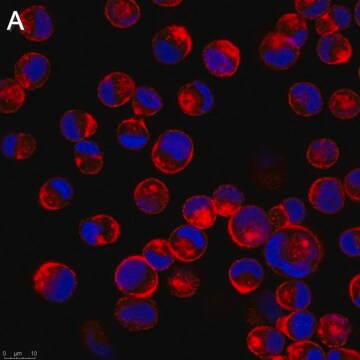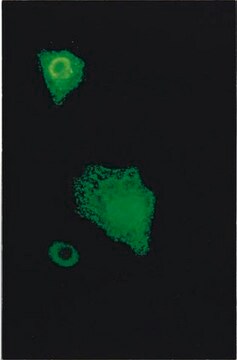推荐产品
生物源
mouse
品質等級
共軛
biotin conjugate
抗體表格
purified immunoglobulin
抗體產品種類
primary antibodies
無性繁殖
A3, monoclonal
物種活性
human
製造商/商標名
Chemicon®
技術
immunofluorescence: suitable
同型
IgG1
運輸包裝
wet ice
特異性
Specific for the Influenza A nucleoprotein. Has stronger binding with N2/N3 type Flu A. No cross reactivity seen to influenza B or other respiratory viruses.
免疫原
Epitope: nucleoprotein
Influenza A
應用
Indirect Immunofluorescence
Optimal dilutions must be determined by end user.
Optimal dilutions must be determined by end user.
Research Category
Infectious Diseases
Infectious Diseases
Research Sub Category
Infectious Diseases - Viral
Infectious Diseases - Viral
This Anti-Influenza A Antibody, nucleoprotein, clone A3, biotin-conjugated is validated for use in IF for the detection of Influenza A.
外觀
Biotin conjugated purified immunoglobulin. Liquid in 0.01M PBS, pH=7.1, 0.1% Sodium Azide with 15 mg/mL BSA as stabilizer.
儲存和穩定性
Maintain at 2 to 8°C for up to 12 months from date of receipt. Protect from Light.
其他說明
Concentration: Please refer to the Certificate of Analysis for the lot-specific concentration.
法律資訊
CHEMICON is a registered trademark of Merck KGaA, Darmstadt, Germany
免責聲明
Unless otherwise stated in our catalog or other company documentation accompanying the product(s), our products are intended for research use only and are not to be used for any other purpose, which includes but is not limited to, unauthorized commercial uses, in vitro diagnostic uses, ex vivo or in vivo therapeutic uses or any type of consumption or application to humans or animals.
未找到合适的产品?
试试我们的产品选型工具.
儲存類別代碼
12 - Non Combustible Liquids
水污染物質分類(WGK)
WGK 2
閃點(°F)
Not applicable
閃點(°C)
Not applicable
Detection of influenza A and B neutralizing antibodies in vaccinated ferrets and macaques using specific biotin-streptavidin conjugated antibodies.
Danylo Sirskyj,Richard Weltzin,Ashkan Golshani,David Anderson,Jasminka Bozic et al.
Journal of Virological Methods null
Jérémie Le Pen et al.
Nature structural & molecular biology, 25(9), 778-786 (2018-08-15)
RNA viruses are a major threat to animals and plants. RNA interference (RNAi) and the interferon response provide innate antiviral defense against RNA viruses. Here, we performed a large-scale screen using Caenorhabditis elegans and its natural pathogen the Orsay virus
Sarah F Andrews et al.
Science immunology, 2(13) (2017-08-08)
Antigenic drift and shift of influenza strains underscore the need for broadly protective influenza vaccines. One strategy is to design immunogens that elicit B cell responses against conserved epitopes on the hemagglutinin (HA) stem. To better understand the elicitation of
Eda K Holl et al.
Proceedings of the National Academy of Sciences of the United States of America, 113(35), 9728-9733 (2016-08-17)
Nucleic acid-containing debris released from dead and dying cells can be recognized as damage-associated molecular patterns (DAMPs) or pattern-associated molecular patterns (PAMPs) by the innate immune system. Inappropriate activation of the innate immune response can engender pathological inflammation and autoimmune
Graham D Williams et al.
Nature communications, 9(1), 465-465 (2018-02-02)
Influenza A virus nucleoprotein (NP) association with viral RNA (vRNA) is essential for packaging, but the pattern of NP binding to vRNA is unclear. Here we applied photoactivatable ribonucleoside enhanced cross-linking and immunoprecipitation (PAR-CLIP) to assess the native-state of NP-vRNA
我们的科学家团队拥有各种研究领域经验,包括生命科学、材料科学、化学合成、色谱、分析及许多其他领域.
联系技术服务部门





